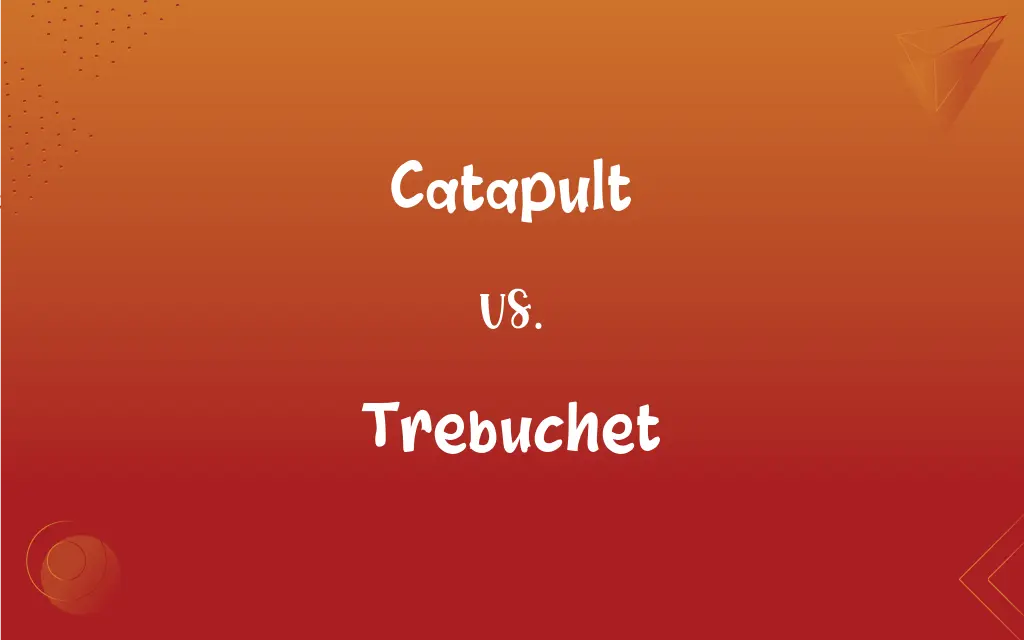Catapult vs. Trebuchet: What's the Difference?
Edited by Janet White || By Harlon Moss || Updated on June 21, 2024
A catapult is a medieval siege engine using tension or torsion; a trebuchet uses a counterweight for launching projectiles.

Key Differences
Catapults operate primarily through tension or torsion, using twisted ropes or a flexed arm to launch projectiles. Trebuchets, conversely, utilize a counterweight system where a heavy weight on one end propels the arm to launch objects.
The catapult has ancient origins, used since Greek and Roman times for siege warfare. The trebuchet was developed later, in the Middle Ages, and was renowned for its superior power and range.
Catapults are often smaller and simpler in design, making them more mobile and easier to construct. In contrast, trebuchets are typically larger and more complex, requiring a sturdy frame to support the heavy counterweight.
Catapults can launch a variety of projectiles effectively, while trebuchets are known for their longer range and greater power, capable of hurling heavier objects further.
There are various types of catapults, including the ballista and mangonel, each with unique designs. Trebuchets are more uniform in design, with variations mainly in size and counterweight.
ADVERTISEMENT
Comparison Chart
Mechanism
Tension or torsion
Counterweight and lever
Development Era
Ancient times
Medieval times
Construction
Simpler, fewer materials
Complex, resource-intensive
Range and Accuracy
Limited range and accuracy
Greater range and accuracy
Energy Source
Twisted ropes or bent arms
Raised counterweight
ADVERTISEMENT
Catapult and Trebuchet Definitions
Catapult
Tension or Torsion Mechanism.
They built a catapult based on torsion principles.
Trebuchet
Heavy Projectile Thrower.
They used the trebuchet to hurl boulders at the enemy walls.
Catapult
Siege Engine.
The army used a catapult to breach the fortress walls.
Trebuchet
Medieval Siege Weapon.
The castle was besieged with a massive trebuchet.
Catapult
Ancient Warfare Tool.
The Roman catapults were formidable in ancient battles.
Trebuchet
Long-Range Siege Engine.
The trebuchet could launch projectiles farther than any catapult.
Catapult
Projectile Launcher.
The catapult was effective in launching stones over great distances.
Trebuchet
Counterweight Launcher.
The trebuchet's counterweight system was a marvel of engineering.
Catapult
Mechanical Device.
His fascination with medieval warfare led him to build a model catapult.
Trebuchet
Middle Ages Warfare Device.
In the Middle Ages, the trebuchet was a key weapon in sieges.
Catapult
Any of various military machines used for hurling missiles, such as large stones or spears, in ancient and medieval times.
Trebuchet
A medieval catapult for hurling stones or other heavy projectiles, often by means of a sling at the end of a long, counterweighted, swinging arm.
Catapult
A mechanism for launching aircraft at a speed sufficient for flight, as from the deck of a carrier.
Trebuchet
A medieval siege engine consisting of a large pivoting arm heavily weighted on one end.
Medieval trebuchets are said to have been capable of launching 90-kg projectiles over distances of more than 300 meters.
Trebuchet
A torture device for dunking suspected witches by means of a chair attached to the end of a long pole.
Trebuchet
To shoot with a trebuchet.
Trebuchet
A cucking stool; a tumbrel.
Trebuchet
A military engine used in the Middle Ages for throwing stones, etc. It acted by means of a great weight fastened to the short arm of a lever, which, being let fall, raised the end of the long arm with great velocity, hurling stones with much force.
Trebuchet
A kind of balance for weighing.
Trebuchet
Medieval artillery used during sieges; a heavy war engine for hurling large stones and other missiles
FAQs
Can a trebuchet launch heavier objects than a catapult?
Yes, trebuchets can generally launch heavier objects further than catapults.
Were catapults used before trebuchets?
Yes, catapults have been used since ancient times, predating trebuchets.
What is a catapult?
A catapult is a siege weapon that launches projectiles using tension or torsion.
How does a trebuchet work?
A trebuchet works by using a counterweight to hurl projectiles.
What's the key difference in the mechanisms of catapults and trebuchets?
Catapults use tension or torsion, while trebuchets use a counterweight.
Did the design of trebuchets vary much historically?
Trebuchets were relatively uniform in design, with variations mainly in size.
Were catapults easy to move?
Some catapults were designed to be more mobile than the larger, stationary trebuchets.
What is the maximum range of a trebuchet?
The range varied, but some large trebuchets could launch projectiles over 300 meters.
Are catapults and trebuchets still used today?
They are not used in modern warfare but are often built for educational or historical demonstrations.
Could catapults be used for defense?
Yes, catapults were used for both offensive and defensive purposes in sieges.
What era is the trebuchet most associated with?
The trebuchet is most associated with the Middle Ages.
Were mangonels and onagers types of catapults?
Yes, both mangonels and onagers are types of catapults.
Did catapults require a lot of maintenance?
Catapults, especially those using torsion, required significant maintenance.
What were common projectiles for catapults?
Catapults commonly launched stones, burning objects, and sometimes even diseased carcasses.
What materials were used to build trebuchets?
Trebuchets were primarily built from wood, metal, and rope.
What is the primary advantage of a trebuchet?
The primary advantage of a trebuchet is its ability to launch heavy projectiles over long distances.
Is a ballista a type of catapult?
Yes, a ballista is a type of ancient catapult, more akin to a giant crossbow.
Did the size of the catapult affect its range?
Yes, the size and design of a catapult significantly affected its range and power.
How accurate were trebuchets?
Trebuchets were relatively accurate for their time, especially at close to medium ranges.
How were trebuchets powered?
Trebuchets were powered by gravity, using the weight of the counterweight.
About Author
Written by
Harlon MossHarlon is a seasoned quality moderator and accomplished content writer for Difference Wiki. An alumnus of the prestigious University of California, he earned his degree in Computer Science. Leveraging his academic background, Harlon brings a meticulous and informed perspective to his work, ensuring content accuracy and excellence.
Edited by
Janet WhiteJanet White has been an esteemed writer and blogger for Difference Wiki. Holding a Master's degree in Science and Medical Journalism from the prestigious Boston University, she has consistently demonstrated her expertise and passion for her field. When she's not immersed in her work, Janet relishes her time exercising, delving into a good book, and cherishing moments with friends and family.






































































